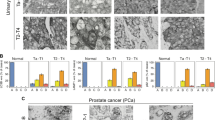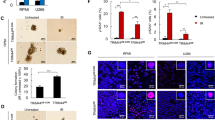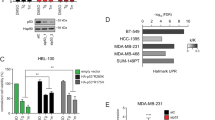Abstract
Dysfunction of the endoplasmic reticulum (ER) has been reported in a variety of human pathologies, including cancer. However, the contribution of the ER to the early stages of normal cell transformation is largely unknown. Using primary human melanocytes and biopsies of human naevi (moles), we show that the extent of ER stress induced by cellular oncogenes may define the mechanism of activation of premature senescence. Specifically, we found that oncogenic forms of HRAS (HRASG12V) but not its downstream target BRAF (BRAFV600E), engaged a rapid cell-cycle arrest that was associated with massive vacuolization and expansion of the ER. However, neither p53, p16INK4a nor classical senescence markers – such as foci of heterochromatin or DNA damage – were able to account for the specific response of melanocytes to HRASG12V. Instead, HRASG12V-driven senescence was mediated by the ER-associated unfolded protein response (UPR). The impact of HRAS on the UPR was selective, as it was poorly induced by activated NRAS (more frequently mutated in melanoma than HRAS). These results argue against premature senescence as a converging mechanism of response to activating oncogenes and support a direct role of the ER as a gatekeeper of tumour control.
This is a preview of subscription content, access via your institution
Access options
Subscribe to this journal
Receive 12 print issues and online access
$209.00 per year
only $17.42 per issue
Buy this article
- Purchase on Springer Link
- Instant access to full article PDF
Prices may be subject to local taxes which are calculated during checkout






Similar content being viewed by others
References
Jemal, A. et al. Cancer statistics, 2005. CA Cancer J. Clin. 55, 10–30 (2005).
Davies, H. et al. Mutations of the BRAF gene in human cancer. Nature 417, 949–954 (2002).
Pollock, P. M. et al. High frequency of BRAF mutations in nevi. Nature Genet. 33, 19–20 (2003).
Michaloglou, C. et al. BRAFE600-associated senescence-like cell cycle arrest of human naevi. Nature 436, 720–724 (2005).
Strungs, I. Common and uncommon variants of melanocytic naevi. Pathology 36, 396–403 (2004).
Papp, T. et al. Mutational analysis of the N-ras, p53, p16INK4a, CDK4, and MC1R genes in human congenital melanocytic naevi. J. Med. Genet. 36, 610–614 (1999).
Bastian, B. C., LeBoit, P. E. & Pinkel, D. Mutations and copy number increase of HRAS in Spitz nevi with distinctive histopathological features. Am. J. Pathol. 157, 967–972 (2000).
Barnhill, R. L. et al. Atypical Spitz nevi/tumors: lack of consensus for diagnosis, discrimination from melanoma, and prediction of outcome. Hum. Pathol. 30, 513–520 (1999).
Maldonado, J. L., Timmerman, L., Fridlyand, J. & Bastian, B. C. Mechanisms of cell-cycle arrest in Spitz nevi with constitutive activation of the MAP-kinase pathway. Am. J. Pathol. 164, 1783–1787 (2004).
Collado, M. & Serrano, M. The power and the promise of oncogene-induced senescence markers. Nature Rev. Cancer 6, 472–476 (2006).
Shay, J. W. & Roninson, I. B. Hallmarks of senescence in carcinogenesis and cancer therapy. Oncogene 23, 2919–2933 (2004).
Campisi, J. Senescent cells, tumor suppression, and organismal aging: good citizens, bad neighbors. Cell 120, 513–522 (2005).
Mallette, F. A., Goumard, S., Gaumont-Leclerc, M. F., Moiseeva, O. & Ferbeyre, G. Human fibroblasts require the Rb family of tumor suppressors, but not p53, for PML-induced senescence. Oncogene 23, 91–99 (2004).
Federovitch, C. M., Ron, D. & Hampton, R. Y. The dynamic ER: experimental approaches and current questions. Curr. Opin. Cell Biol. 17, 409–414 (2005).
Schroder, M. & Kaufman, R. J. The mammalian unfolded protein response. Annu. Rev. Biochem. 74, 739–789 (2005).
Lee, A. S. The glucose-regulated proteins: stress induction and clinical applications. Trends Biochem. Sci. 26, 504–510 (2001).
Lassot, I. et al. ATF4 degradation relies on a phosphorylation-dependent interaction with the SCF(βTrCP) ubiquitin ligase. Mol. Cell. Biol. 21, 2192–2202 (2001).
Vallejo, M., Ron, D., Miller, C. P. & Habener, J. F. C/ATF, a member of the activating transcription factor family of DNA-binding proteins, dimerizes with CAAT/enhancer-binding proteins and directs their binding to cAMP response elements. Proc. Natl Acad. Sci. USA 90, 4679–4683 (1993).
Harding, H. P. et al. Regulated translation initiation controls stress-induced gene expression in mammalian cells. Mol. Cell 6, 1099–1108 (2000).
Ron, D. & Hampton, R. Y. Membrane biogenesis and the unfolded protein response. J. Cell Biol. 167, 23–25 (2004).
Jamora, C., Dennert, G. & Lee, A. S. Inhibition of tumor progression by suppression of stress protein GRP78/BiP induction in fibrosarcoma B/C10ME. Proc. Natl Acad. Sci. USA 93, 7690–7694 (1996).
Romero-Ramirez, L. et al. XBP1 is essential for survival under hypoxic conditions and is required for tumor growth. Cancer Res. 64, 5943–5947 (2004).
Xu, C., Bailly-Maitre, B. & Reed, J. C. Endoplasmic reticulum stress: cell life and death decisions. J. Clin. Invest. 115, 2656–2664 (2005).
Malumbres, M. & Barbacid, M. RAS oncogenes: the first 30 years. Nature Rev. Cancer 3, 459–465 (2003).
Philips, M. R. Compartmentalized signalling of Ras. Biochem. Soc. Trans. 33, 657–661 (2005).
Matallanas, D. et al. Distinct utilization of effectors and biological outcomes resulting from site-specific Ras activation: Ras functions in lipid rafts and Golgi complex are dispensable for proliferation and transformation. Mol. Cell. Biol. 26, 100–116 (2006).
Ackermann, J. et al. Metastasizing melanoma formation caused by expression of activated N-RasQ61K on an INK4a-deficient background. Cancer Res. 65, 4005–4011 (2005).
Li, W., Zhu, T. & Guan, K. L. Transformation potential of Ras isoforms correlates with activation of phosphatidylinositol 3-kinase but not ERK. J. Biol. Chem. 279, 37398–37406 (2004).
Lin, A. W. et al. Premature senescence involving p53 and p16 is activated in response to constitutive MEK/MAPK mitogenic signaling. Genes Dev. 12, 3008–3019 (1998).
Narita, M. et al. Rb-mediated heterochromatin formation and silencing of E2F target genes during cellular senescence. Cell 113, 703–716 (2003).
Bauer, J. & Bastian, B. Genomic analysis of melanocytic neoplasia. Adv. Dermatol. 21, 81–99 (2005).
Narita, M. & Lowe, S. W. Senescence comes of age. Nature Med. 11, 920–922 (2005).
Sharpless, N. E. & DePinho, R. A. Cancer: crime and punishment. Nature 436, 636–637 (2005).
Braig, M. et al. Oncogene-induced senescence as an initial barrier in lymphoma development. Nature 436, 660–665 (2005).
Chen, Z. et al. Crucial role of p53-dependent cellular senescence in suppression of Pten-deficient tumorigenesis. Nature 436, 725–730 (2005).
Collado, M. & Serrano, M. The senescent side of tumor suppression. Cell Cycle 4, 1722–1724 (2005).
Guerra, C. et al. Tumor induction by an endogenous K-ras oncogene is highly dependent on cellular context. Cancer Cell 4, 111–120 (2003).
Benanti, J. A. & Galloway, D. A. Normal human fibroblasts are resistant to RAS-induced senescence. Mol. Cell. Biol. 24, 2842–2852 (2004).
Lowe, S. W., Cepero, E. & Evan, G. Intrinsic tumour suppression. Nature 432, 307–315 (2004).
te Poele, R. H., Okorokov, A. L., Jardine, L., Cummings, J. & Joel, S. P. DNA damage is able to induce senescence in tumor cells in vitro and in vivo. Cancer Res. 62, 1876–1883 (2002).
Ma, Y. & Hendershot, L. M. The role of the unfolded protein response in tumour development: friend or foe? Nature Rev. Cancer 4, 966–977 (2004).
Li, J. & Lee, A. S. Stress induction of GRP78/BiP and its role in cancer. Curr. Mol. Med. 6, 45–54 (2006).
Sriburi, R., Jackowski, S., Mori, K. & Brewer, J. W. XBP1: a link between the unfolded protein response, lipid biosynthesis, and biogenesis of the endoplasmic reticulum. J. Cell Biol. 167, 35–41 (2004).
Back, S. H., Lee, K., Vink, E. & Kaufman, R. J. Cytoplasmic IRE1α-mediated XBP1 mRNA splicing in the absence of nuclear processing and endoplasmic reticulum stress. J. Biol. Chem. 281, 18691–18706 (2006).
Harding, H. P. et al. An integrated stress response regulates amino acid metabolism and resistance to oxidative stress. Mol. Cell 11, 619–633 (2003).
Blais, J. D. et al. Activating transcription factor 4 is translationally regulated by hypoxic stress. Mol. Cell. Biol. 24, 7469–7482 (2004).
Dai, D. L., Martinka, M. & Li, G. Prognostic significance of activated Akt expression in melanoma: a clinicopathologic study of 292 cases. J. Clin. Oncol. 23, 1473–1482 (2005).
Miyauchi, H. et al. Akt negatively regulates the in vitro lifespan of human endothelial cells via a p53/p21-dependent pathway. EMBO J. 23, 212–220 (2004).
Hamanaka, R. B., Bennett, B. S., Cullinan, S. B. & Diehl, J. A. PERK and GCN2 contribute to eIF2α phosphorylation and cell cycle arrest after activation of the unfolded protein response pathway. Mol. Biol. Cell 16, 5493–5501 (2005).
Ranganathan, A. C., Zhang, L., Adam, A. P. & Aguirre-Ghiso, J. A. Functional coupling of p38-induced up-regulation of BiP and activation of RNA-dependent protein kinase-like endoplasmic reticulum kinase to drug resistance of dormant carcinoma cells. Cancer Res. 66, 1702–1711 (2006).
Wang, Y. et al. Activation of ATF6 and an ATF6 DNA binding site by the endoplasmic reticulum stress response. J. Biol. Chem. 275, 27013–27020 (2000).
Acknowledgements
We are grateful to A. Bengtson, T.P. Miller and W.-H. Tang for technical support; K. Zhang for advice with UPR-related dominant-negative constructs; J. Martens for help with the time-lapse microscopy; S. Núñez, E. de Stanchina and S. Lowe for p16 shRNA lentiviral vector and AKT-DN retroviral constructs; K. Guan and A. Vojtek for HA-tagged BRAF pcDNA; D. Peeper for pBabe-puro-BRAF; and W. Tirasophon and T. Ruthowski for ATF-6 and IRE1 antibodies. We also thank G. Núñez, J.A. Esteban, M. Serrano, G. Ferbeyre and A. Dlugosz for helpful suggestions and critical reading of this manuscript. This work was supported by a postdoctoral fellowship from La Ligue Contre le Cancer (C.D); Career Development Awards from the Dermatology Foundation to M.S.S. and M.A.N.; the Elsa U. Pardee Foundation (M.S.S); and National Institutes of Health grants CA107237 (M.S.S), R33 CA95300 (B.C.B.), DK42394 (R.J.K) and A112243 and U01CA83180 (S.B.G). M.S.S. is a V Foundation for Cancer Research Scholar.
Author information
Authors and Affiliations
Contributions
C.D. and M.S.S. designed the study. C.D., G.A-R., M.V. and M.S.S. performed all studies with primary melanocytes. T.M.J., D.R.F., J.P., S.B.G. and L.S. provided specimens for inital testing of stress factors in human naevi. Common and Spitz naevi shown or mentioned in this study were analysed for HRAS, BRAF and NRAS status by V.B. and B.C.B. V.B. and B.C.B. performed and scored the immunostaining of naevi with antibodies against PDI and GRP78, and M.S.S. performed statistical tests. M.A.N. and R.J.K. provided reagents for the generation of lentiviral vectors expressing shRNA against UPR proteins. C.D. and M.S.S. wrote the manuscript.
Corresponding author
Ethics declarations
Competing interests
The authors declare no competing financial interests.
Supplementary information
Supplementary Information
Supplementary figures S1, S2, S3, S4, S5, S6 and Supplementary information. (PDF 1555 kb)
Rights and permissions
About this article
Cite this article
Denoyelle, C., Abou-Rjaily, G., Bezrookove, V. et al. Anti-oncogenic role of the endoplasmic reticulum differentially activated by mutations in the MAPK pathway. Nat Cell Biol 8, 1053–1063 (2006). https://doi.org/10.1038/ncb1471
Received:
Accepted:
Published:
Issue Date:
DOI: https://doi.org/10.1038/ncb1471
This article is cited by
-
Secreted protein markers in oral squamous cell carcinoma (OSCC)
Clinical Proteomics (2022)
-
The endoplasmic reticulum stress response in prostate cancer
Nature Reviews Urology (2022)
-
Zinc ions negatively regulate proapoptotic signaling in cells expressing oncogenic mutant Ras
BioMetals (2022)
-
Unfolded protein response in colorectal cancer
Cell & Bioscience (2021)
-
Endoplasmic reticulum stress signals in the tumour and its microenvironment
Nature Reviews Cancer (2021)



